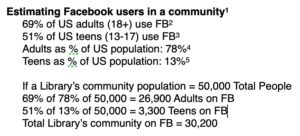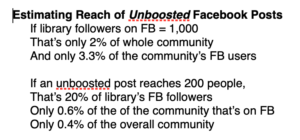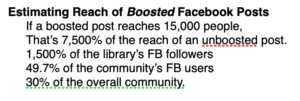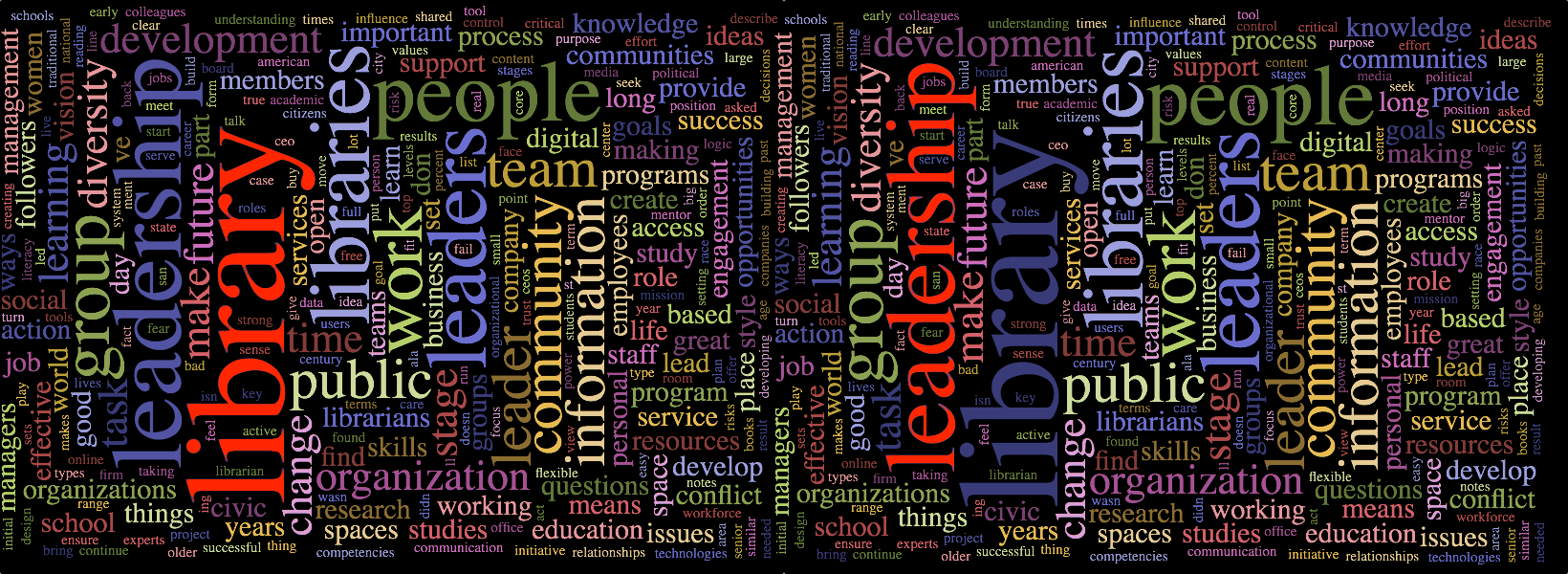In the age of COVID, libraries have turned increasingly to social media to get the word out about ongoing activities. Patrons are no longer coming into the library building, so how do we tell them about all the stuff going on in virtual library space? A small social media marketing budget can increase the effectiveness of outreach by over 1,000%. This post presents a simple case study of inexpensive, effective social media marketing that can be applied to most public and academic libraries.
Many libraries have turned to Facebook (FB) posts to announce events, programs and services. We must ask, however, are libraries really reaching their patrons by merely posting their announcements on Facebook?
 If a library serves a community of 50,000 residents, maybe 1,000 (2%) of them follow the library on FB. Worse (and many libraries don’t realize this) few FB posts reach even half of the people who follow the library. In fact, in most cases a library is lucky if any given post reaches 20% of its FB followers.
If a library serves a community of 50,000 residents, maybe 1,000 (2%) of them follow the library on FB. Worse (and many libraries don’t realize this) few FB posts reach even half of the people who follow the library. In fact, in most cases a library is lucky if any given post reaches 20% of its FB followers.
 Given that math, in a community of 50,000 people, only 200 (0.4%) residents will see any given post. If a library announces a big event, such as an interactive webinar on keeping kids engaged with school during the pandemic, the library will reach only a tiny percentage of the community with its announcement. Furthermore, many of those who are reached may not be parents of elementary school age kids. If a third of the people reached by the post are too young or too old to have children, out of 50,000 residents only about 80 people who might possibly be interested will see the announcement.
Given that math, in a community of 50,000 people, only 200 (0.4%) residents will see any given post. If a library announces a big event, such as an interactive webinar on keeping kids engaged with school during the pandemic, the library will reach only a tiny percentage of the community with its announcement. Furthermore, many of those who are reached may not be parents of elementary school age kids. If a third of the people reached by the post are too young or too old to have children, out of 50,000 residents only about 80 people who might possibly be interested will see the announcement.
What if there were a way to reach many more interested residents for as little as $50 per week?
Targeted boosting of Facebook posts is a possible solution. Targeted boosting on FB allows libraries to make sure that community residents meeting selected demographic characteristics see library posts. The boost for each post can be targeted differently depending on the audience for the library service being promoted.
For example, I advised NCC Japan on how to improve their outreach to their approximately 750 FB followers. NCC Japan works with Japan Studies scholars and librarians in the USA and Japan to find and exchange academic resources. People who know about NCC are enthusiastic about its services but not all know the full gamut of services available through NCC. Typically, each FB post reached only 100 to 125 followers.
In NCC Japan’s case, for $2 per day over a five day period in April 2020, we boosted one FB post. Doing so made sure that the post reached 538of their 750 Facebook followers who logged onto Facebook during those five days. By boosting this post we more than quadrupled the reach.
I also advised NCC Japan to boost some of their posts to Facebook users who had never heard of NCC before but might be interested in its programs and content.
 For $10 per day over a five day period, NCC Japan boosted a post to reach more than 17,000 Facebook users who were selected based on geography, education, profession and academic interest. None of the 17,000 who saw the boosted NCC FB post were current followers of NCC. Over 700 people engaged with the post, clicking through to NCC Japan’s FB page, and many became NCC FB followers. Even those who did not engage with the ad at least had NCC’s name and logo presented to them, which will make them more receptive to future NCC boosted posts.
For $10 per day over a five day period, NCC Japan boosted a post to reach more than 17,000 Facebook users who were selected based on geography, education, profession and academic interest. None of the 17,000 who saw the boosted NCC FB post were current followers of NCC. Over 700 people engaged with the post, clicking through to NCC Japan’s FB page, and many became NCC FB followers. Even those who did not engage with the ad at least had NCC’s name and logo presented to them, which will make them more receptive to future NCC boosted posts.
One time advertisements are usually not enough to attract all the possible people who might be interested in a particular library program or event. However, each boosted FB post will reach far more of those people than a post that is not boosted, especially if the objective is to reach people who are not currently engaging with the library but could be. Over time, more of those unengaged community members will become engaged community members.
If libraries consider the labor and other resource costs that are spent on programs, dedicating a small budget to promoting greater awareness of and participation in events and programs is an excellent investment. If it costs $500 to organize an event and 100 people attend, the cost is $5 per person. If a $50 promotional budget is added and 10 more people attend, the cost per person is still $5, but 10 more people have participated. If more than 10 additional people participate, the cost per person begins to shrink. Furthermore, of course, when new people attend an event, it is possible to promote additional events and get them even more involved in the library.
It is not enough to simply post on social media. It must be done effectively. One of the remarkable things about social media marketing is just how inexpensive it is. Effective social media marketing simply requires a small budget, some expertise and practice.
1. These are gross estimates that will vary dramatically from community to community. A little research should produce more accurate figures for any given community.
2. Pew Research. 2019. https://www.pewresearch.org/fact-tank/2019/05/16/facts-about-americans-and-facebook/
3. IBID
4. US Census. 2019. QuickFacts United States. https://www.census.gov/quickfacts/fact/table/US/PST045219 Accessed Jan 12, 2021
5. Act for Youth. U.S. Teen Demographics. http://actforyouth.net/adolescence/demographics/ Accessed Jan 12, 2021
